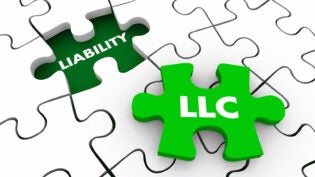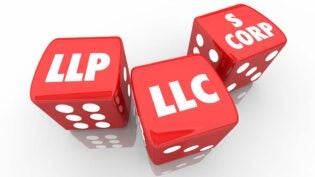
Selecting a business entity is one of the most important decisions you will make when starting your business. There are many types of business entities that you can choose from, each with their own strengths and weaknesses. Go over this general overview of the different kinds of business entities, in increasing complexity, and see which ones might work for you, then follow through and get more details about the ones you are interested in.
Sole Proprietorship
A sole proprietorship is the simplest form of business entity, operated by a single person. There are no legal formalities required to start a sole proprietorship, and the owner is a self-employed individual, not an employee. The sole proprietor and its owner are taxed as a single entity, with business income simply reported in the owner’s tax returns. There are downsides to this simplest form of business entity, though. You may be subject to unlimited personal liability, since there is no separation between the business and the individual. All of the assets and liabilities of the company are also the assets and liabilities of its owner.
General Partnership
A general partnership is a business entity operated by two or more people, with a partnership agreement spelling out the exact terms of the partnership. In this entity, the partners agree to share money, labor, and skill, and in turn will proportionally share profits and losses. As in a sole proprietorship, the partners are considered self-employed individuals, not employees, and their share of the partnership’s income must be reported on their personal income tax returns. The risks are also similar to a sole proprietorship, as the personal assets of the partners are not legally separated from the business, opening the door for personal liability.
Limited Partnership
A limited partnership differs from a general partnership in that it includes both one or more general partners as well as one or more limited partners. In this form of business entity, the limited partners are not personally liable for the partnership’s debts, while general partners still are. The limited partner can only lose the amount of money invested or received from the business, protecting personal assets. However, limited partners cannot participate in the business’s management, or else they risk personal liability. The purpose of this business entity is to raise money from limited partners without taking on additional active partners or starting a complex, stock-issuing corporation.
Limited Liability Company
A limited liability company, or LLC, is one of the newest types of business entities. The members form the company under state law and adopt an operating agreement for the LLC. An LLC can have just one member, or many members, allowing great flexibility. The LLC has a few major benefits. First, it protects its members from personal liability, legally separating the individual from the company. Second, it has the flexibility to be taxed in any way the members see fit. For a single member LLC, income is taxed as if it were a sole proprietorship, while multi-member LLCs can either be taxed as a partnership or as a corporation, as its members see fit.
Regular Corporation (C Corporation)
A C Corporation is considered a separate entity from the individuals who own or operate it. This form of business entity is created under state law to carry out business, and has its own name and identity. No matter whether there is only one employee or many, the assets and liabilities of the corporation are separate from any individuals associated with it. Stock in the corporation may all be owned by one person or by many shareholders. The corporation protects you by limiting your personal liability. However, corporations may be subject to double taxation. The corporation’s income is taxed, and it will be taxed again if it is distributed to shareholders in the form of dividends.
S Corporation
The S Corporation is a hybrid form of business entity, in that it offers the limited liability of a corporation while being taxed like a sole proprietorship or partnership. S Corporations avoid the double taxation problem facing C Corporations, because income passes directly through the corporation, without being taxed, to the shareholders, who then pay income tax on their share of the company’s profits and losses. There are strict requirements for an S Corporation, including a limit of no more than 100 shareholders, all of whom must be citizens or residents of the United States. If you go through all the requirements for an S Corporation and find that your business would be eligible, you can file to become an S Corporation with the IRS. If at any point your business no longer meets the requirements, the company will go back to being a C Corporation.
Professional Corporation
The Professional Corporation is the only way for certain occupations to incorporate their practices in some states. Physicians, attorneys, and accountants are among the categories permitted in this form of business entity. Every shareholder in the corporation must be licensed. Contact your state’s corporation filing office to find out which professions require professional corporations in your state; some states require these professions to form professional corporations, while others permit regular corporations as well as professional corporations.
Published: December 17, 2012
6645 Views
6645 Views












